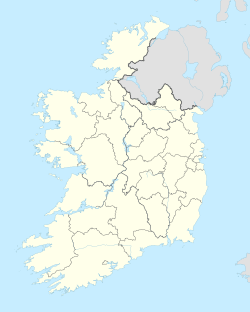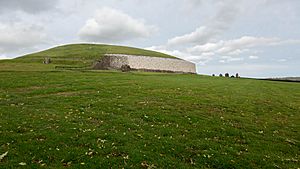Newgrange cursus facts for kids
|
Sruth na Gráinsí Nua
|
|
| Location | valley of the River Boyne |
|---|---|
| Region | County Meath, Ireland |
| Coordinates | 53°41′42″N 6°28′23″W / 53.695135°N 6.473093°W |
| Type | cursus |
| Part of | Brú na Bóinne |
| Length | 100 m |
| Width | 20 m |
| Type | Cultural |
| Criteria | i, iii, iv |
| Designated | 1993 (17th session) |
| Part of | Brú na Bóinne - Archaeological Ensemble of the Bend of the Boyne |
| Reference no. | 659 |
| Ireland | |
| Region | Europe and North America |
The Newgrange cursus is an ancient monument from the Neolithic period, also known as the New Stone Age. It was likely used as a special pathway for ceremonies within the larger Brú na Bóinne area. This old trackway is about 100 meters (328 feet) long and 20 meters (65 feet) wide. You can find it near Newgrange, in County Meath, Ireland.
What is a Cursus?
A cursus is a special kind of ancient pathway. It was often used for important ceremonies or processions. These pathways are usually long and narrow. They have parallel banks (raised earth) and ditches (dug-out areas) along their sides. The only breaks in these borders are for entrances and exits. At the end of a cursus, there's usually a rounded or square-shaped area.
The Newgrange Cursus
The Newgrange cursus is located about 100 meters (328 feet) east of the famous Newgrange passage tomb. It is in County Meath, Ireland. This ancient route runs in a north-south direction. It is made up of two parallel banks that are 20 meters (65 feet) apart.
The cursus probably started from an area that was once a pond, but is now dry. It then goes east-west, sloping upwards, to the north of the Newgrange ridge. The southern end of the track is closed off by a U-shaped terminal. Today, about 100 meters (328 feet) of this prehistoric track still exist.
Who Named the Cursus?
The word "cursus" was created by an Antiquarian named William Stukeley (1687-1765). He was a person who studied ancient things. In the 1700s, he used this term to describe a long earthwork track at Stonehenge. Stonehenge is a famous prehistoric monument in Wiltshire, England.
Stukeley first thought the Stonehenge track was used as a Roman racecourse. The word "cursus" comes from Latin and means "course." Today, "cursus" describes long, narrow trackways or rectangular enclosures. These are believed to be ancient monuments used for processions.
Other Cursus Monuments
There are several cursus monuments found in Ireland and Britain. They come in different forms, shapes, sizes, and have various boundaries. For example, in Scotland, about half of the known cursus monuments have boundaries made of pits or post-holes. In County Meath, Ireland, the cursus linked to the passage tomb at Loughcrew has inner ditches and outer banks.



